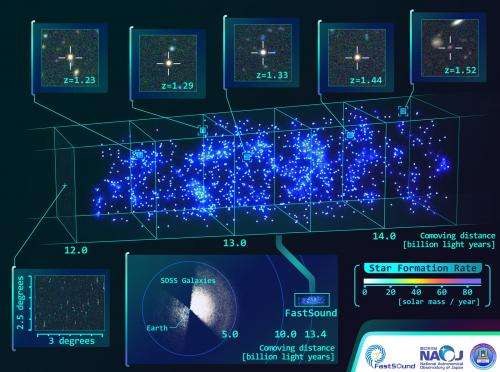Constructing a 3-D map of the large-scale structure of the universe

An international team led by astronomers from Kyoto University, the University of Tokyo and the University of Oxford has released its first version of a 3D map of the Universe from its FastSound project, which is surveying galaxies in the Universe over nine billion light years away. Using the Subaru Telescope's new Fiber Multi-Object Spectrograph (FMOS), the team's 3D map includes 1,100 galaxies and shows the large-scale structure of the Universe nine billion years ago (Figure 1).
The FastSound project, one of Subaru Telescope's Strategic Programs, began its observations in March 2012 and will continue them into the spring of 2014. Although surveys with 3D maps of the Universe have been conducted on the nearby Universe (e.g., the Sloan Digital Sky Survey with coverage up to five billion light years away), the FastSound project distinguishes itself by developing a 3D map of the far-distant Universe, covering the largest volume of the Universe farther than ten billion light years away. Subaru Telescope's FMOS facilitates the project's goal of surveying a large portion of the sky. FMOS is a powerful wide-field spectroscopy system that enables near-infrared spectroscopy of over 100 objects at a time; the spectrograph's location at prime focus allows an exceptionally wide field of view when combined with the light colleting power of the 8.2 m primary mirror of the telescope.
The current 3D map of 1,100 galaxies shows the large-scale structure of the Universe nine billion years ago, spanning 600 million light years along the angular direction and two billion light years in the radial direction. The team will eventually survey a region totaling about 30 square degrees in the sky and then measure precise distances to about 5000 galaxies that are more than ten billion light years away. Although the clustering of galaxies is not as strong as that of the present-day Universe, gravitational interaction will eventually result in clustering that grows to the current level.
The final 3D map of the distant Universe will serve a primary scientific goal of the project: to precisely measure the motion of galaxies and then measure the rate of growth of the large-scale structure as a test of Einstein's general theory of relativity. Although scientists know that the expansion of the Universe is accelerating, they do not know why; it is one of the biggest questions in contemporary physics and astronomy. An unknown form of energy, so-called "dark energy", appears to uniformly fill the Universe, accounting for about 70% of its mass-energy content and apparently causing its acceleration. Alternatively, a fundamental theory of gravity on cosmological scales may differ from that of general relativity, which reigns as the dominant theory of gravitation and spacetime. A comparison of the 3D map of the young Universe with the predictions of general relativity could eventually reveal the mechanism for the mysterious acceleration of the Universe.
Provided by Subaru Telescope




















